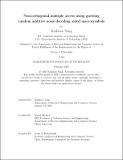| dc.contributor.advisor | Médard, Muriel | |
| dc.contributor.author | Yang, Kathleen | |
| dc.date.accessioned | 2025-03-27T17:00:49Z | |
| dc.date.available | 2025-03-27T17:00:49Z | |
| dc.date.issued | 2025-02 | |
| dc.date.submitted | 2025-03-04T17:26:38.238Z | |
| dc.identifier.uri | https://hdl.handle.net/1721.1/158962 | |
| dc.description.abstract | We propose guessing random additive noise decoding-aided macrosymbols (GRANDAM) as a nonorthogonal multiple access (NOMA) method that can detect, error correct, and decode multiple users in multiple input multiple output (MIMO) systems that involve imperfect channel estimation, symbol-wise asynchronous transmission, and interference. GRAND-AM is a NOMA method that uses both joint multiuser detection and joint error correction decoding to handle multiple access interference (MAI) from the users of interest. Our method avoids codebook design and iterative decoding techniques, which are associated with other commonly researched NOMA techniques. We introduce the concept of a macrosymbol, which is constructed from the combination of all user symbols, for the joint detection component of GRANDAM. For the error correction decoding component, we introduce multiple access channel (MAC) codes, which are codes that are used to split the channel rate between users and correct errors due to the MAI. Each user has their information bits encoded with independent MAC codes, which can be short, low rate linear codes such as cyclic redundancy check (CRC) codes or space time codes such as the Alamouti code. We use a soft detection variant of GRAND, a near maximum likelihood (ML) universal decoding algorithm that inverts noise effect sequences from a sequence of symbols to arrive at a codeword, to correct the received sequence of macrosymbols, and ensure that all user codebooks are simultaneously satisfied in the joint decoding process. We show that the methodology of using joint detection and joint decoding at the receiver leads to lower error rates compared to an individual detection and decoding technique, and has comparable performance to an orthogonal multiple access (OMA) system with a similar code rate and length. | |
| dc.publisher | Massachusetts Institute of Technology | |
| dc.rights | In Copyright - Educational Use Permitted | |
| dc.rights | Copyright retained by author(s) | |
| dc.rights.uri | https://rightsstatements.org/page/InC-EDU/1.0/ | |
| dc.title | Non-orthogonal multiple access using guessing random additive noise decoding aided macrosymbols | |
| dc.type | Thesis | |
| dc.description.degree | Ph.D. | |
| dc.contributor.department | Massachusetts Institute of Technology. Department of Electrical Engineering and Computer Science | |
| mit.thesis.degree | Doctoral | |
| thesis.degree.name | Doctor of Philosophy | |
